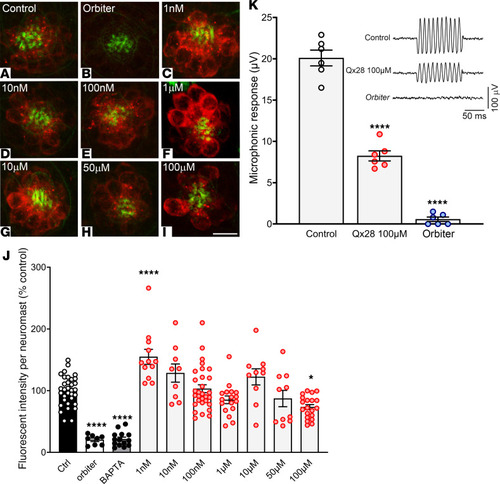
Hair cell activity in the presence of Qx28. (A?I) Five dpf WT larvae were preincubated in E3 water without (A and B) or with different Qx28 concentrations (C?I) for 1 hour and then cotreated with FM1-43 3 ?M for 20 seconds. (J) The fluorescence incorporated per neuromast (red) was measured using ImageJ (NIH) and expressed as a percentage from control. The orbiter line (B) (52, 53) and fish preincubated with BAPTA were used as negative controls. Phalloidin counterstaining is shown in green. Results are expressed as mean ± SEM. Statistical analysis: 1-way ANOVA with correction for Dunnett?s multiple comparisons test. *P < 0.05, ****P < 0.0001 versus control. Number of neuromasts quantified: control = 33, orbiter = 8, BAPTA = 14, Qx28 1 nM = 12, Qx28 10 nM = 9, Qx28 100 nM = 30, Qx28 1 ?M = 17, Qx28 10 ?M and 50 ?M = 10, Qx28 100 ?M = 20. Scale bar: 7 ?m. (K) Means ± SEM of the magnitude of microphonic responses from 6 dpf zebrafish in the presence of vehicle or Qx28 100 ?M. Statistical analysis: Student?s 2-tailed t test. ****P < 0.0001 versus control. Measurements were obtained from 1 neuromast per fish from a total of 6 fish per condition. Top right: Microphonic potential traces of 6 dpf zebrafish in the presence of vehicle or Qx28 100 ?M. The orbiter line was used as a negative control.
|

